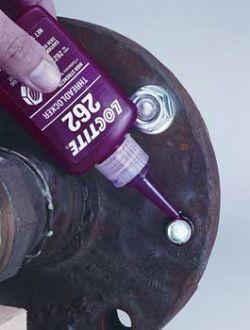| TODAY liquid threadlockers, as opposed to traditional mechanical fasteners, are the preferred option for fastening. But what are the key factors to consider when choosing a threadlocker, and why do they perform so much better? Various methods and devices have been employed over the years to reduce or prevent loss of clamp load in threaded fasteners. Anaerobic (chemical) threadlockers are the latest invention designed to perform where mechanical devices fail, as these reduce or prevent loss of clamp load in threaded fasteners. Threadlockers based on anaerobic technology do what the mechanical aids cannot; they completely fill up the microscopic gaps between interfacing threads. According to Henkel, tests have proven that bolts secured with threadlockers retain clamping forces better than mechanical devices. In a transverse shock and vibration machine, liquid threadlockers outperformed mechanical locking devices. Bolts secured with threadlocker retained nearly all their clamping force after more than 1000 cycles. Threadlockers are not just for specialised uses; they perform effectively on fasteners and threaded assemblies of any type and size, in any kind of equipment. However, in order to get the optimum performance of the fasteners, it is critical to use the right threadlocking product during the assembly. “There are many determining factors when selecting a threadlocker to achieve optimum performance,” says Henkel’s Di Felice. “Such as shear strength, cure speed, gap-filling and operating environment.” Threaded fasteners hold together assemblies undergoing different degrees of motion and that need dismantling for repairs or maintenance from time-to time. Threadlockers need to provide adequate strengths depending on requirements of the fastener. Moreover they need to allow for easy repair, maintenance and overhaul. The cure speed of threadlockers depends on several factors, including temperature, base metal, surface treatments, clearance between parts, and surface cleanliness. The use of chemical primers can accelerate curing and result in higher ultimate strength. Most threaded fasteners are designed with some clearance between their mating surfaces. Thiotropic liquid threadlockers are superior when it comes to gap filling and will easily fill clearances in threaded fasteners, without migrating to other areas of the assembly. Both chemical resistance and operating temperature must be considered when selecting a liquid threadlocker. Threadlockers are available in low-strength and medium-strength grades that can be removed using common hand tools, and high-strength formulations that offer the highest threadlocking abilities. Felice says selecting the right threadlocker is an extremely important step to help fastener threads grip and prevent loss of clamp load. “Once one fastener unravels, vibration increases, loosening another fastener, and then another, leading to catastrophic failure and unscheduled downtime. Using the right liquid threadlocker is key to preventing this and ensuring optimum performance of equipment”. |
Contact:
|






